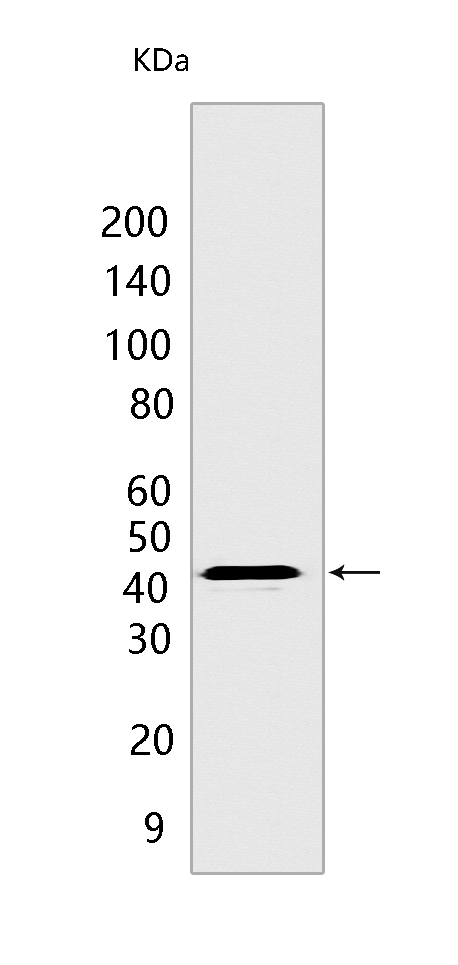P-CDK9 (T186) Rabbit pAbCat NO.: A26490
Western blot(SDS PAGE) analysis of extracts from NIH/3T3 cells.Using P-CDK9 (T186) Rabbit pAb at dilution of 1:1000 incubated at 4℃ over night.
Product information
Protein names :CDK9,CDC2L4,TAK,CDK9_HUMAN,Cyclin-dependent kinase 9
UniProtID :P50750
MASS(da) :42,778
MW(kDa) :42, 55 kDa
Form :Liquid
Purification :peptide affinity chromatography
Host :Rabbit
Isotype :IgG
sensitivity :Endogenous
Reactivity :Human,Mouse,Rat
- ApplicationDilution
- 免疫印迹(WB)1:1000-2000
- The optimal dilutions should be determined by the end user
Specificity :Antibody is produced by immunizing animals with a synthetic peptide at the sequence of Human Phospho-CDK9 (Thr186)
Storage :Antibody store in 10 mM PBS, 0.5mg/ml BSA, 50% glycerol. Shipped at 4°C. Store at-20°C or -80°C. Products are valid for one natural year of receipt.Avoid repeated freeze / thaw cycles.
WB Positive detected :NIH/3T3 cells
Function : Protein kinase involved in the regulation of transcription (PubMed:10574912, PubMed:10757782, PubMed:11145967, PubMed:11575923, PubMed:11809800, PubMed:11884399, PubMed:14701750, PubMed:16109376, PubMed:16109377, PubMed:20930849, PubMed:28426094, PubMed:29335245). Member of the cyclin-dependent kinase pair (CDK9/cyclin-T) complex, also called positive transcription elongation factor b (P-TEFb), which facilitates the transition from abortive to productive elongation by phosphorylating the CTD (C-terminal domain) of the large subunit of RNA polymerase II (RNAP II) POLR2A, SUPT5H and RDBP (PubMed:10574912, PubMed:10757782, PubMed:11145967, PubMed:11575923, PubMed:11809800, PubMed:11884399, PubMed:14701750, PubMed:16109376, PubMed:16109377, PubMed:20930849, PubMed:28426094). This complex is inactive when in the 7SK snRNP complex form (PubMed:10574912, PubMed:10757782, PubMed:11145967, PubMed:11575923, PubMed:11809800, PubMed:11884399, PubMed:14701750, PubMed:16109376, PubMed:16109377, PubMed:20930849, PubMed:28426094). Phosphorylates EP300, MYOD1, RPB1/POLR2A and AR and the negative elongation factors DSIF and NELFE (PubMed:9857195, PubMed:10912001, PubMed:11112772, PubMed:12037670, PubMed:20081228, PubMed:20980437, PubMed:21127351). Regulates cytokine inducible transcription networks by facilitating promoter recognition of target transcription factors (e.g. TNF-inducible RELA/p65 activation and IL-6-inducible STAT3 signaling) (PubMed:17956865, PubMed:18362169). Promotes RNA synthesis in genetic programs for cell growth, differentiation and viral pathogenesis (PubMed:10393184, PubMed:11112772). P-TEFb is also involved in cotranscriptional histone modification, mRNA processing and mRNA export (PubMed:15564463, PubMed:19575011, PubMed:19844166). Modulates a complex network of chromatin modifications including histone H2B monoubiquitination (H2Bub1), H3 lysine 4 trimethylation (H3K4me3) and H3K36me3,integrates phosphorylation during transcription with chromatin modifications to control co-transcriptional histone mRNA processing (PubMed:15564463, PubMed:19575011, PubMed:19844166). The CDK9/cyclin-K complex has also a kinase activity towards CTD of RNAP II and can substitute for CDK9/cyclin-T P-TEFb in vitro (PubMed:21127351). Replication stress response protein,the CDK9/cyclin-K complex is required for genome integrity maintenance, by promoting cell cycle recovery from replication arrest and limiting single-stranded DNA amount in response to replication stress, thus reducing the breakdown of stalled replication forks and avoiding DNA damage (PubMed:20493174). In addition, probable function in DNA repair of isoform 2 via interaction with KU70/XRCC6 (PubMed:20493174). Promotes cardiac myocyte enlargement (PubMed:20081228). RPB1/POLR2A phosphorylation on 'Ser-2' in CTD activates transcription (PubMed:21127351). AR phosphorylation modulates AR transcription factor promoter selectivity and cell growth. DSIF and NELF phosphorylation promotes transcription by inhibiting their negative effect (PubMed:9857195, PubMed:10912001, PubMed:11112772). The phosphorylation of MYOD1 enhances its transcriptional activity and thus promotes muscle differentiation (PubMed:12037670). Catalyzes phosphorylation of KAT5, promoting KAT5 recruitment to chromatin and histone acetyltransferase activity (PubMed:29335245)..
Tissue specificity :Ubiquitous.
Subcellular locationi :Nucleus. Cytoplasm. Nucleus, PML body.
IMPORTANT: For western blots, incubate membrane with diluted primary antibody in 1% w/v BSA, 1X TBST at 4°C overnight.


